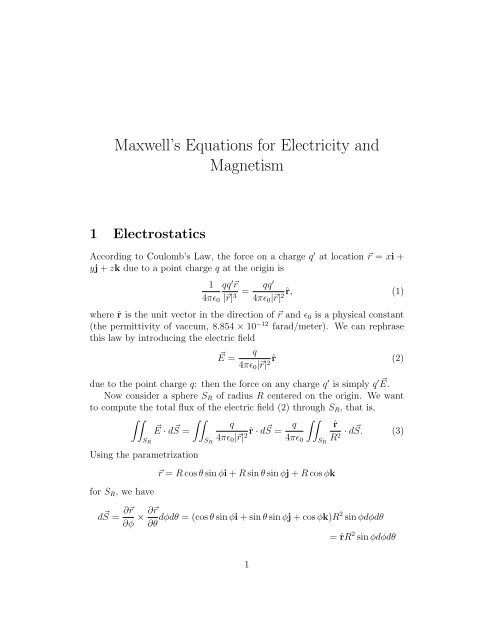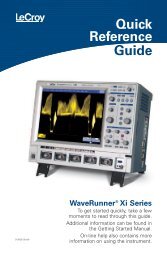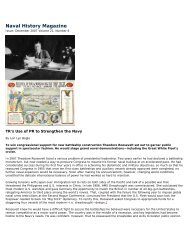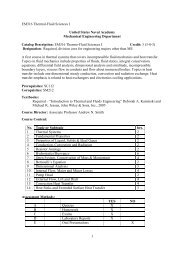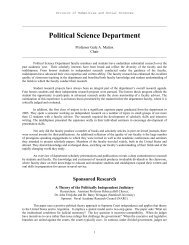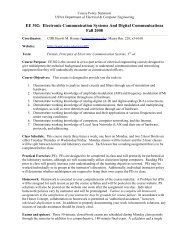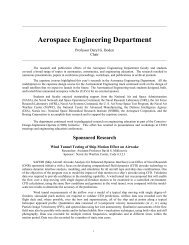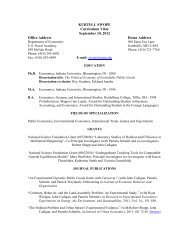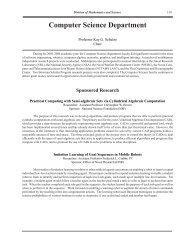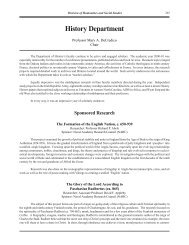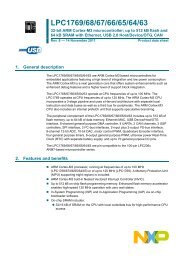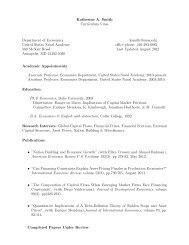Maxwell's Equations for Electricity and Magnetism
Maxwell's Equations for Electricity and Magnetism
Maxwell's Equations for Electricity and Magnetism
Create successful ePaper yourself
Turn your PDF publications into a flip-book with our unique Google optimized e-Paper software.
Maxwell’s <strong>Equations</strong> <strong>for</strong> <strong>Electricity</strong> <strong>and</strong><br />
<strong>Magnetism</strong><br />
1 Electrostatics<br />
According to Coulomb’s Law, the <strong>for</strong>ce on a charge q ′ at location ⃗r = xi +<br />
yj + zk due to a point charge q at the origin is<br />
1 qq ′ ⃗r<br />
4πɛ 0 |⃗r| = qq′ ˆr, (1)<br />
3 4πɛ 0 |⃗r|<br />
2<br />
where ˆr is the unit vector in the direction of ⃗r <strong>and</strong> ɛ 0 is a physical constant<br />
(the permittivity of vaccum, 8.854 × 10 −12 farad/meter). We can rephrase<br />
this law by introducing the electric field<br />
q<br />
⃗E = ˆr (2)<br />
4πɛ 0 |⃗r|<br />
2<br />
due to the point charge q: then the <strong>for</strong>ce on any charge q ′ is simply q ′ E. ⃗<br />
Now consider a sphere S R of radius R centered on the origin. We want<br />
to compute the total flux of the electric field (2) through S R , that is,<br />
∫∫<br />
E ⃗ · dS ⃗ =<br />
∫∫S R<br />
Using the parametrization<br />
<strong>for</strong> S R , we have<br />
S R<br />
q<br />
4πɛ 0 |⃗r| 2 ˆr · d⃗ S =<br />
q ∫∫<br />
4πɛ 0<br />
⃗r = R cos θ sin φi + R sin θ sin φj + R cos φk<br />
S R<br />
ˆr<br />
R 2 · d⃗ S. (3)<br />
d ⃗ S = ∂⃗r<br />
∂φ × ∂⃗r<br />
∂θ dφdθ = (cos θ sin φi + sin θ sin φj + cos φk)R2 sin φdφdθ<br />
= ˆrR 2 sin φdφdθ<br />
1
<strong>and</strong> so the integral (3) becomes<br />
∫<br />
q 2π<br />
4πɛ 0<br />
0<br />
∫ π<br />
0<br />
ˆr<br />
R 2 · ˆrR2 sin φdφdθ =<br />
q ∫ 2π<br />
4πɛ 0<br />
0<br />
∫ π<br />
0<br />
sin φdφdθ =<br />
q<br />
4π = q . (4)<br />
4πɛ 0 ɛ 0<br />
Notice that this result is independent of the radius R of the sphere. In fact<br />
this calculation can be generalized: if Σ is any closed surface containing the<br />
origin, then<br />
∫∫<br />
Σ<br />
⃗E · d ⃗ S = q ɛ 0<br />
. (5)<br />
Now the electric field is additive: that is, the electric field E ⃗ due to two point<br />
charges q <strong>and</strong> q ′ is the sum of the electric field due to q <strong>and</strong> the electric field<br />
due to q ′ . It follows that <strong>for</strong> any collection of point charges, the electric field<br />
⃗E satisfies the equation<br />
∫∫<br />
⃗E · dS ⃗ = 1 (sum of charges contained in Σ) (6)<br />
ɛ 0<br />
Σ<br />
This is the integral <strong>for</strong>m of Gauss’s Law. Notice that if Σ surrounds a positive<br />
charge, then both sides of equation (6) are positive: if Σ surrounds a negative<br />
charge, both sides of (6) are negative. That is, positive charges are sources<br />
of the electric field E, ⃗ <strong>and</strong> negative charges are sinks of E. ⃗<br />
Now if we think of charges as being “spread out” rather than concentrated<br />
at a point, there is a charge density ρ so that<br />
∫∫∫<br />
ρdV = total charge contained in D<br />
Thus, equation (6) becomes<br />
∫∫<br />
D<br />
Σ<br />
⃗E · d ⃗ S = 1 ɛ 0<br />
∫∫∫<br />
D<br />
ρdV,<br />
where D is the region inside Σ. Using the divergence theorem, this is<br />
∫∫∫<br />
∇ · ⃗EdV = 1 ∫∫∫<br />
∫∫∫<br />
ρdV, or (∇ ·<br />
ɛ ⃗E − ρ )dV = 0.<br />
0 ɛ 0<br />
D<br />
Since this holds <strong>for</strong> any region D, we have<br />
which is the differential <strong>for</strong>m of Gauss’s Law.<br />
D<br />
D<br />
∇ · ⃗E = ρ ɛ 0<br />
, (7)<br />
2
2 The Magnetic Field<br />
There is also a magnetic field ⃗ B. Stationary charges are not affected by the<br />
magnetic field, but moving charges are. In fact, a charge q ′ with velocity<br />
vector ⃗v will feel a magnetic <strong>for</strong>ce q ′ ⃗v × ⃗ B. Putting this together with the<br />
electrical <strong>for</strong>ce, the <strong>for</strong>ce felt by a charge q ′ is the so-called Lorentz <strong>for</strong>ce<br />
q ′ ( ⃗ E + ⃗v × ⃗ B). (8)<br />
Unlike the electrical field, the magnetic field ⃗ B has no sources or sinks.<br />
That is, there are no isolated magnetic “charges” (magnetic monopoles).<br />
Instead, magnets always have a north pole <strong>and</strong> a south pole: if you break<br />
a magnet in half, you get two smaller magnets each with its own north <strong>and</strong><br />
south pole. The lack of sources <strong>and</strong> sinks can be expressed as<br />
∇ · ⃗B = 0. (9)<br />
It was discovered experimentally that moving electrical charges (current)<br />
create a magnetic field. If we consider a small pierce of wire d⃗r with a current<br />
I flowing through it, the contribution it makes to the magnetic field at the<br />
point ⃗r is given by the Biot-Savart Law:<br />
dB ⃗ = µ 0 Id⃗r × ⃗r<br />
= µ 0 Id⃗r × ˆr<br />
, (10)<br />
4π |⃗r| 3 4π |⃗r| 2<br />
where µ 0 is a physical constant (the permeability of vacuum, 4π × 10 −7<br />
henry/meter). Note the similarity to Coulomb’s Law (2): like the electric<br />
field, the magnetic field is inversely proportional to the square of the distance.<br />
Now we consider an infinite straight wire carrying current I, <strong>and</strong> calculate<br />
the magnetic field B ⃗ at a point distance R from the wire. Choose coordinates<br />
so i points down the wire, <strong>and</strong> our point is at position Rj. Then equation<br />
(10) says that<br />
⃗B = µ 0<br />
4π<br />
∫ ∞<br />
−∞<br />
Iidx × (−xi + Rj)<br />
(x 2 + R 2 ) 3 2<br />
= µ 0k<br />
4π<br />
∫ ∞<br />
−∞<br />
RIdx<br />
(x 2 + R 2 ) 3 2<br />
= µ 0I<br />
2πR k.<br />
That is, the field strength is µ 0I<br />
, <strong>and</strong> the direction is perpendicular to the<br />
2πR<br />
axis of the wire. It follows that if we take a circle C of radius R whose center<br />
is on the wire (<strong>and</strong> whose diameters are perpendicular to the wire), then<br />
∫ ∫<br />
µ 0 I<br />
⃗B · d⃗r =<br />
2πR dr = µ 0I<br />
2πR (2πR) = µ 0I. (11)<br />
C<br />
C<br />
3
Note that the result does not depend on R (as in equation (4)). As with<br />
equation (4), equation (11) generalizes: For any path C around the wire,<br />
∫<br />
⃗B · d⃗r = µ 0 I = µ 0 (current enclosed by C) (12)<br />
C<br />
This is Ampere’s Law (in integral <strong>for</strong>m). Now Stokes’s theorem says that<br />
∫ ∫∫<br />
⃗B · d⃗r = (∇ × B) ⃗ · dS,<br />
⃗<br />
C<br />
where S is a surface with boundary curve C. If we introduce a current density<br />
⃗J so that<br />
∫∫<br />
I = ⃗J · dS,<br />
⃗<br />
then equation (12) becomes<br />
∫∫<br />
∫∫<br />
(∇ × B) ⃗ · dS ⃗ = µ 0<br />
S<br />
As S is arbitrary, this implies<br />
S<br />
⃗J · d ⃗ S,<br />
S<br />
S<br />
or<br />
∫∫<br />
S<br />
(∇ × B − µ 0 J) · d ⃗ S = 0.<br />
∇ × B = µ 0 J, (13)<br />
the differential <strong>for</strong>m of Ampere’s Law.<br />
A changing magnetic field creates an electric field. This Faraday Induction<br />
Law was discovered experimentally, <strong>and</strong> can be stated as follows.<br />
Suppose we have a loop C of wire. Then the line integral ∫ E · d⃗r is related<br />
C<br />
to the flux of the magnetic field B ⃗ through a surface S having boundary<br />
curve C:<br />
∫<br />
⃗E · d⃗r = − d ∫∫<br />
⃗B · dS C dt<br />
⃗ (14)<br />
S<br />
(note the presence of the time derivative here!). That is, the circulation of the<br />
electric field is minus the rate of change in the magnetic flux. The integral<br />
<strong>for</strong>m (14) has a corresponding differential <strong>for</strong>m. Using Stokes’s theorem,<br />
equation(14) becomes<br />
∫∫<br />
(∇ × E)d⃗r ⃗ = − d<br />
S<br />
dt<br />
from which we get the differential equation<br />
∫∫<br />
∇ × ⃗ E = − d ⃗ B<br />
dt<br />
4<br />
S<br />
⃗B · d ⃗ S,<br />
(15)
3 Maxwell’s <strong>Equations</strong><br />
If we collect equations (7), (15), (9) <strong>and</strong> (13), we have<br />
∇ · ⃗E = ρ ɛ 0<br />
(16)<br />
∇ × E ⃗ = − ∂ B ⃗<br />
∂t<br />
(17)<br />
∇ · ⃗B = 0 (18)<br />
∇ × ⃗ B = µ 0<br />
⃗ J (19)<br />
Maxwell studied these equations, <strong>and</strong> realized there was something not quite<br />
right about the last one. If we take divergences of both sides of equation<br />
(19), we get (since divergence of a curl is zero)<br />
0 = µ 0 ∇ · ⃗J (20)<br />
But experimentally, electrical charge is seen to be conserved. For any closed<br />
surface Σ, the rate at which current flows out of Σ is equal to the decrease<br />
of total charge in the volume D enclosed by Σ. That is,<br />
∫∫<br />
⃗J · dS ⃗ = − d ∫∫∫<br />
ρdV<br />
dt<br />
Using the divergence theorem, this is<br />
∫∫∫<br />
Since D is arbitrary, this means<br />
Σ<br />
D<br />
(<br />
∇ · ⃗J + ∂ρ<br />
∂t<br />
D<br />
)<br />
dV = 0.<br />
∇ · ⃗J = − ∂ρ<br />
∂t , (21)<br />
which contradicts equation (20) if the charge density ρ isn’t constant. Maxwell<br />
reasoned that since a changing magnetic field ⃗ B produces an electric field ⃗ E,<br />
perhaps a changing electric field ⃗ E also produces a magnetic field ⃗ B. That<br />
is, he tried adding a term to equation (19):<br />
∇ × ⃗ B = µ 0<br />
⃗ J + K<br />
∂ ⃗ E<br />
∂t . (22)<br />
5
Now take the divergence of both sides of (22) to get<br />
(using equation (17)), or<br />
0 = µ 0 ∇ ⃗ J + K ∂ ∂t (∇ × ⃗ E) = µ 0 ∇J + K ɛ 0<br />
∂ρ<br />
∂t ,<br />
∇ ⃗ J = − K<br />
ɛ 0 µ 0<br />
∂ρ<br />
∂t . (23)<br />
To make equation (23) agree with (21), we must take<br />
K = µ 0 ɛ 0<br />
<strong>and</strong> so the corrected equation (19) reads<br />
∇ × ⃗ B = µ 0<br />
⃗ J + µ0 ɛ 0<br />
∂ ⃗ E<br />
∂t ,<br />
<strong>and</strong> the correct Maxwell equations are<br />
∇ · ⃗E = ρ ɛ 0<br />
∇ × ⃗ E = − ∂ ⃗ B<br />
∂t<br />
∇ · ⃗B = 0<br />
∇ × ⃗ B = µ 0<br />
⃗ J + µ0 ɛ 0<br />
∂ ⃗ E<br />
∂t .<br />
4 A Consequence: Electromagnetic Waves<br />
In a region of space without current or charge, the Maxwell equations imply<br />
∇ · ⃗E = 0 (24)<br />
∇ × ⃗ E = − ∂ ⃗ B<br />
∂t<br />
(25)<br />
∇ × ⃗ B = µ 0 ɛ 0<br />
∂ ⃗ E<br />
∂t . (26)<br />
Now <strong>for</strong> any vector field ⃗ F = F 1 i + F 2 j + F 3 k, it’s true that<br />
∇ × (∇ × ⃗ F ) = ∇(∇ · ⃗F ) − (∇ 2 F 1 i + ∇ 2 F 2 j + ∇ 2 F 3 k) (27)<br />
6
where ∇ 2 f is the Laplacian<br />
∇ 2 f = ∂2 f<br />
∂x 2 + ∂2 f<br />
∂y 2 + ∂2 f<br />
∂z 2 ,<br />
as can be shown by a direct (but somewhat tedious) calculation. Applying<br />
equation (27) to ⃗ F = ⃗ E <strong>and</strong> using equation (24), we have<br />
∇ × (∇ × ⃗ E) = −(∇ 2 E 1 i + ∇ 2 E 2 j + ∇ 2 E 3 k). (28)<br />
On the other h<strong>and</strong>, using equations (25) <strong>and</strong> (26), we have<br />
(<br />
∇ × (∇ × E) ⃗ ∂B<br />
= −∇ ×<br />
⃗ )<br />
= − ∂ ∂t ∂t (∇ × B) ⃗ ∂ 2 E ⃗<br />
= −µ 0 ɛ 0<br />
∂t . (29)<br />
2<br />
Comparing equations (28) <strong>and</strong> (29), we must have<br />
∇ 2 E 1 = µ 0 ɛ 0<br />
∂ 2 E 1<br />
∂t 2 , ∇2 E 2 = µ 0 ɛ 0<br />
∂ 2 E 2<br />
∂t 2 , <strong>and</strong> ∇2 E 3 = µ 0 ɛ 0<br />
∂ 2 E 3<br />
∂t 2 .<br />
Now the differential equation<br />
∇ 2 f = 1 c 2 ∂ 2 f<br />
∂t 2<br />
is the wave equation <strong>for</strong> a wave travelling with speed c. Thus, it follows from<br />
Maxwell’s equations that in regions of space without charge or current, all<br />
components of ⃗ E satisfy the wave equation with speed<br />
c = 1 √<br />
µ0 ɛ 0<br />
. (30)<br />
A similar argument shows that all components of ⃗ B satisfy the wave equation<br />
with the same c.<br />
This led to a profound realization: light (as well as ultraviolet, infrared,<br />
radio waves, etc.) is really an electromagnetic wave. Further, the speed of<br />
light c can be calculated from the electric <strong>and</strong> magnetic constants µ 0 <strong>and</strong><br />
ɛ 0 using equation (30). Thus, one of the most important discoveries of the<br />
nineteenth century came from a mathematical re<strong>for</strong>mulation of the laws of<br />
electromagnetism.<br />
7


